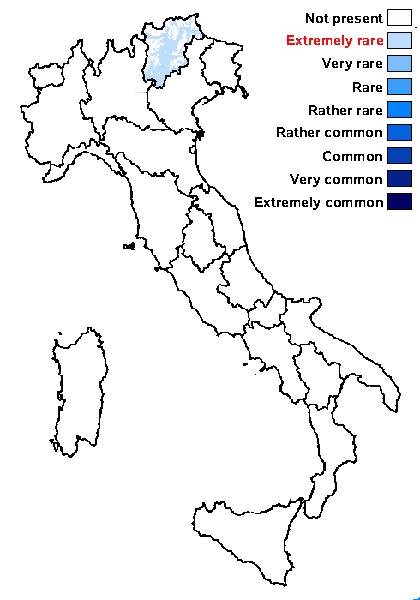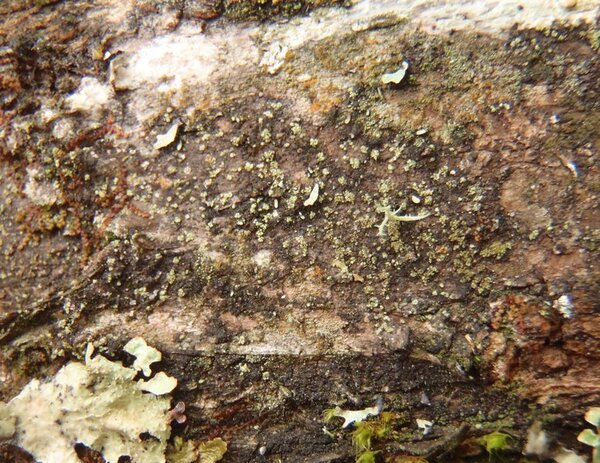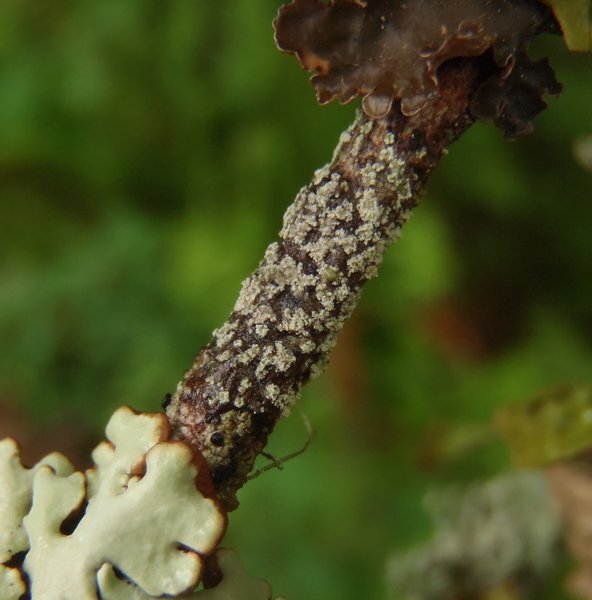Rinodina subpariata (Nyl.) Zahlbr.
Cat. Lich. Univ., 7: 554, 1931.. Basionym: Lecanora subpariata Nyl. - Acta Soc. Sci. Fenn., 26: 30, 1900.
Synonyms: Rinodina degeliana Coppins
Distribution: N - TAA (Nascimbene 2014, Nascimbene & Marini 2015, Trindade & al. 2021, Nascimbene & al. 2022).
Description: Thallus crustose, episubstratic, mostly irregularly spreading, areolate, sorediate, forming small round patches or rarely extended and up to 10 cm in diam., usually without a distinct prothallus, the areoles grey-white or grey-green, irregularly rounded or more or less angular, 0.3-0.8 mm wide, at first flat and adnate, later sometimes tending to become raised at edges and appearing subsquamulose. Soralia pure white, persistently discrete or more rarely more or less confluent, developing marginally on the slightly raised underside of areoles, linear at first, later often more or less labriform; some areoles often completely dissolved into diffuse soralia. Soredia farinose, whitish grey to greyish green, 20-40 µm in diam., often gathered in larger consoredia. Apothecia very rare, lecanorine, sessile, constricted at base, 0.3-0.9 mm across, with a blackish brown, flat disc, and an often sorediate thalline margin; proper margin visible, becoming prominent, blackish brown. Thalline exciple 60-100 µm wide laterally, with a 10-20 µm thick cortex, the cortical cells not pigmented and mostly hidden by crystals; proper exciple colourless or pale brown, 5-10 µm wide laterally, expanding to 20-30 µm in upper part; epithecium reddish brown; hymenium colourless, (75-)90-120 µm high; not inspersed with oil droplets; paraphyses strongly coherent, 2-2.5 µm thick at mid-level, the apical cells 3.5-4.5 µm wide; hypothecium colourless or very pale brown, 70-140 µm high. Asci (4-)8-spored, clavate, the K/I+ blue tholus penetrated by a faintly amyloid apical cushion with parallel or diverging flanks, the wall K/I-, surrounded by a K/I+ blue outer layer, Lecanora-type. Ascospores 1-septate, brown, ellipsoid, 18-25 x 10-14 µm, Physcia- to Physconia-type, with and ornamented wall and a type A ontogeny (apical wall thickening after the early septum formation). Pycnidia rare, immersed, brown to black. Conidia bacilliform, 3.5-4.5 x c. 1 µm. Photobiont chlorococcoid. Spot tests: K+ yellow, C-, KC-, P+ bright lemon yellow. Chemistry: atranorin, chloroatranorin, zeorin.Note: an apparently rare, but also easily overlooked sorediate lichen with a holarctic distribution, growing on bark in rather shaded and humid situations, mostly in the deciduous forest belts.
Growth form: Crustose
Substrata: bark
Photobiont: green algae other than Trentepohlia
Reproductive strategy: mainly asexual, by soredia, or soredia-like structures (e.g. blastidia)
Commonnes-rarity: (info)
Alpine belt: absent
Subalpine belt: absent
Oromediterranean belt: absent
Montane belt: extremely rare
Submediterranean belt: extremely rare
Padanian area: absent
Humid submediterranean belt: absent
Humid mediterranean belt: absent
Dry mediterranean belt: absent

Predictive model
Herbarium samples
Growth form: Crustose
Substrata: bark
Photobiont: green algae other than Trentepohlia
Reproductive strategy: mainly asexual, by soredia, or soredia-like structures (e.g. blastidia)
Commonnes-rarity: (info)
Alpine belt: absent
Subalpine belt: absent
Oromediterranean belt: absent
Montane belt: extremely rare
Submediterranean belt: extremely rare
Padanian area: absent
Humid submediterranean belt: absent
Humid mediterranean belt: absent
Dry mediterranean belt: absent

Predictive model
| Herbarium samples |
 Index Fungorum
Index Fungorum
 GBIF
GBIF




